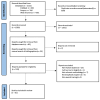Over 30 Years of DiI Use for Human Neuroanatomical Tract Tracing: A Scoping Review
- PMID: 38785943
- PMCID: PMC11117484
- DOI: 10.3390/biom14050536
Over 30 Years of DiI Use for Human Neuroanatomical Tract Tracing: A Scoping Review
Abstract
In the present study, we conducted a scoping review to provide an overview of the existing literature on the carbocyanine dye DiI, in human neuroanatomical tract tracing. The PubMed, Scopus, and Web of Science databases were systematically searched. We identified 61 studies published during the last three decades. While studies incorporated specimens across human life from the embryonic stage onwards, the majority of studies focused on adult human tissue. Studies that utilized peripheral nervous system (PNS) tissue were a minority, with the majority of studies focusing on the central nervous system (CNS). The most common topic of interest in previous tract tracing investigations was the connectivity of the visual pathway. DiI crystals were more commonly applied. Nevertheless, several studies utilized DiI in a paste or dissolved form. The maximum tracing distance and tracing speed achieved was, respectively, 70 mm and 1 mm/h. We identified studies that focused on optimizing tracing efficacy by varying parameters such as fixation, incubation temperature, dye re-application, or the application of electric fields. Additional studies aimed at broadening the scope of DiI use by assessing the utility of archival tissue and compatibility of tissue clearing in DiI applications. A combination of DiI tracing and immunohistochemistry in double-labeling studies have been shown to provide the means for assessing connectivity of phenotypically defined human CNS and PNS neuronal populations.
Keywords: DiI; axonal tracing; carbocyanine dyes; neuroanatomical tracing; neuroanatomy; post-mortem human brain.
Conflict of interest statement
The authors declare no conflicts of interest.
Figures


Similar articles
-
Fluorescent double-labeling with carbocyanine neuronal tracing and immunohistochemistry using a cholesterol-specific detergent digitonin.J Neurosci Methods. 2008 Sep 15;174(1):71-81. doi: 10.1016/j.jneumeth.2008.07.003. Epub 2008 Jul 15. J Neurosci Methods. 2008. PMID: 18674563
-
Testing the suitability of neuroanatomical tracing method in human fetuses with long years of postmortem delay.Surg Radiol Anat. 2022 May;44(5):769-783. doi: 10.1007/s00276-022-02942-7. Epub 2022 Apr 27. Surg Radiol Anat. 2022. PMID: 35476150
-
Carbocyanine postmortem neuronal tracing. Influence of different parameters on tracing distance and combination with immunocytochemistry.J Histochem Cytochem. 1998 Aug;46(8):901-10. doi: 10.1177/002215549804600805. J Histochem Cytochem. 1998. PMID: 9671441
-
Neuroanatomical Tracing Techniques in the Ear: History, State of the Art, and Future Developments.Methods Mol Biol. 2016;1427:243-62. doi: 10.1007/978-1-4939-3615-1_14. Methods Mol Biol. 2016. PMID: 27259931 Free PMC article. Review.
-
Current concepts in neuroanatomical tracing.Prog Neurobiol. 2000 Nov;62(4):327-51. doi: 10.1016/s0301-0082(00)00019-8. Prog Neurobiol. 2000. PMID: 10856608 Review.
Cited by
-
Three-dimensional visualization of Hertwig's epithelial root sheath during tooth root development with the miniTESOS tissue clearing method.Am J Transl Res. 2024 Sep 15;16(9):4403-4421. doi: 10.62347/PEIQ4730. eCollection 2024. Am J Transl Res. 2024. PMID: 39398600 Free PMC article.
-
Beyond Motor Control: Diffusion MRI Reveals Associations between the Cerebello-VTA Pathway and Socio-affective Behaviors in Humans.J Neurosci. 2025 May 7;45(19):e0096252025. doi: 10.1523/JNEUROSCI.0096-25.2025. J Neurosci. 2025. PMID: 40335151 No abstract available.
-
Historical trends in neuroanatomical tract-tracing techniques.Anat Sci Int. 2025 Aug 24. doi: 10.1007/s12565-025-00892-9. Online ahead of print. Anat Sci Int. 2025. PMID: 40849866 Review.
References
Publication types
MeSH terms
Substances
LinkOut - more resources
Full Text Sources
Research Materials
Miscellaneous

